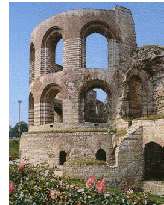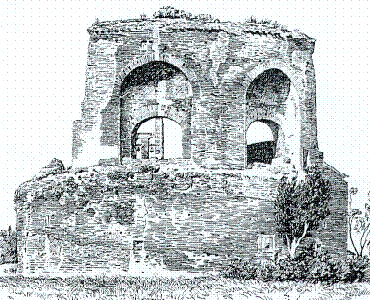Helena Augusta | Basilica Santes Marcellino et Pietro / Mausoleum of Constantine Rome | 1 |
Cemetery of Sts. Peter and Marcellinus, known also as ad duas lauros, ad Helenam from the neighbouring (ruined) mausoleum of St. Helena (Tor Pignattara), and sub Augusta, in comitatu, from a neighbouring villa of Emperor Constantine. St. Peter and St. Marcellinus suffered under Diocletian. They were honoured with a fine Damasan epitaph known to us from the early medieval epigraphic collections. Here also were buried St. Tiburtius, son of the city prefect, Chromatius, and the obscurely known group called the "Quattuor Coronati", four marble-cutters from the Danubian region. The splendid porphyry sarcophagus at the Vatican came from the mausoleum of St. Helena. In 826 the bodies of Peter and Marcellinus were stolen from the crypt and taken to Germany, where they now rest at Seligenstadt; the story is graphically told by Einhard (Mon. Germ. Hist., Script., XV, 39). Since 1896 excavations have been resumed here, and have yielded important results, among them the historic crypt of Sts. Peter and Marcellinus and a small chapel of St. Tiburtius. Wilpert discovered here and illustrated a number of important frescoes: Our Lord amid four saints, the Annunciation, the Adoration of the Magi, the Good Shepherd, Oranti, and some miracles of Christ (Wilpert, Di un ciclo di rappresentanze cristologiche nel cimitero dei SS. Pietro e Marcellino, Rome, 1892). Elsewhere are scenes that represent the agape, or love-feast, of the primitive Christians, symbolic of paradise or of the Eucharist. There is also a noteworthy fresco of the Blessed Virgin with the Infant Jesus between two adoring Magi. This cemetery is said to have been more richly decorated with frescoes than any other except that of Domitilla.
|
chronology of Santes Marcellino et Pietro
303-305
Martyrdom of Peter and Marcellinus in Rome during the persecution under Diocletian, and burial of their remains through Lucilla, as reported to Damasus in his boyhood by the executioner himself.
313-c.320
Brickstamps O F S R found in masonry of Mausoleum of Helena.
324-326
Coin of Constantine, minted during these years, found embedded in mortar of Mausoleum of Helena.
314-335
During the pontificate of Sylvester, Constantine is reported to have built "inter duas lauros" a basilica in honor of two martyrs, the presbyter Marcellinus and the exorcist Peter, and a mausoleum for his mother, Helena. "For the love of his mother and the veneration of the Saints", Constantine endowed these foundations with two sets of gifts. Firstly, a gold paten, a huge golden chandelier, four gold-plated candlesticks each 12 feet high, and a silver alter weighing 200 pounds, were placed in front of the porphyry sarcophagus of the empress. Secondly, the basilica of the martyrs was endowed with another altar weighing 200 pounds and numerous altar vessels, among them a goblet of gold, inscribed with the name of the dowager empress. The list of the endowment of the basilica continues with the enumeration of many other gifts, such as 900 pounds of nard oil and 100 pounds of balsam annually, for incense for the holy martyrs, and huge landed properties, including the fundus Laurentium which had been the property of the dowager-empress Helena, extending from Porta Maggiore to Centocelle, between Via Prenestina and the Via Latina; also other holdings in Italy and Sardinia. The whole endowment, with an income of 3750 solidi, is the largest of the donations attributed by the Liber Pontificalis to Constantine, except for those assigned to the Lateran, the Lateran baptistery and, supposedly, St. Paul's.
|
At the same time Constantine Augustus built a basilica to the blessed martyrs Marcellinus, the priest, and Peter, the exorcist, at Inter duas Lauros; also a mausoleum where his mother, Helena Augusta, was buried1 on the Via Lavicana, at the 3rd milestone. And in this place, both for love of his mother and for veneration of the saints, he offered votive gifts: [or: At the same time Constantine Augustus built a basilica on the Via Lavicana at Inter duas Lauros to blessed Peter and Marcellinus, the martyrs; also a mausoleum where the most blessed Augusta, his mother, was buried in a sarcophagus of porphyry, and he offered there:]
|
1. The remains of the mausoleum of the empress Helena and the catacomb of Santi Pietro e Marcllino may be seen about two miles from the Porta Maggiore at a place now called Tor Pignattara on the Via Casilina, which was formerly the Via Labicana. The basilica has completely disappeared. An imperial palace stood near by, "ad Duas Lauros," near the two laurels, in the time of Septimus Severus and was the scene of the assassination of Valentinian III in 455. The mausoleum is octagonal in shape and surmounted with a dome. In the sixteenth century Bosio saw the ruins of a great courtyard and portico about it, all of which have now vanished. Eusebius says that the body of the empress was transported in state to Rome for burial. Life of Constantine, Richardson, Nicine and Post-Nicene Fathers, Ser. 2, vol. I, P. 532.
|
Quondam © 2014.04.01 |


